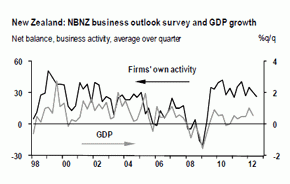
By Ben K. Jarman*
 The NBNZ business confidence index took a small step back in September (from 19.5 to 17.0), but the outlook for firms’ own activity rose for the third month in a row (26.4 to 29.3), and most of the survey subcomponents turned for the better.
The NBNZ business confidence index took a small step back in September (from 19.5 to 17.0), but the outlook for firms’ own activity rose for the third month in a row (26.4 to 29.3), and most of the survey subcomponents turned for the better.
In terms of their own prospects, firms appear to be experiencing the usual seasonal thawing in mood after the Winter chill, and while the discrepancy between overall confidence and firms’ own outlook sends a mixed message, the broader measures in the survey (profits, employment, capacity utilization) all are ticking higher, consistent with an economy that is withstanding the headwinds of deleveraging and currency strength.
Sentiment in the construction and agriculture/export sectors have been at polar extremes throughout the last year or so, and while that gap widened in September, it did so in a positive way, with both aggregates moving higher.
The strength in the construction outlook indices remains striking, and while there was a sense a few months ago that the economy was vulnerable to disappointment in having all its eggs in the Canterbury reconstruction basket, the acceleration in building permits shows that the housing story is gaining momentum.
Government officials also have made speeches over the last couple of months emphasizing the declining trend in seismic activity. As reconstruction activity starts to pay dividends, the residential (46.7 to 52.0) and commercial (21.9 to 34.8) construction indices have pushed back to old highs.
The agriculture sector has been having a much tougher time of late, in dealing with difficult livestock conditions, a global supply glut in dairy that was depressing export prices, and of course the strength of the currency.
While there appears no relief from stifling NZD, there has been broader improvement in the former two channels, which was reflected in today’s survey, with the livestock index turning less negative (-11.1 to -2.9) and the export outlook index improving from 16.9 to 18.0. The latter admittedly is still low in the context of the survey’s history, but to get improvement in two out of three channels mentioned above ain’t bad and, as we wrote following yesterday’s trade data, with commodity prices dynamics turning from headwind to tailwind, the remainder of the year should be pretty positive for exports, particularly given that volumes have not suffered much so far from NZD strength.
With capacity utilization moving modestly higher, inflation expectations ticked up a little too, from 2.34% to 2.39%.
While we don’t want to read too much into subtle turns the price indicators, the combination of a firming in the inflation outlook (and the pricing intentions index, up a touch from 16.1 to 17.4) and seemingly more dovish interest rate expectations (net % expecting an increase vs decrease fell from 18.7 to 15.8) is interesting, and summarizes well the uncertainties surrounding policy at present.
We agree with the general premise that incoming RBNZ Governor Wheeler will be biased to inaction in the near term. But that has implications for both the likelihood of rate cuts and rate hikes in 2013, both of which previously have been assigned non-trivial probabilities given the conflicting dynamics of New Zealand’s anaemic recovery, combined with renewed simmering of housing credit, rents, and house prices.
Similarly, the new Governor’s PTA, signed last week, raises more questions on this front.
The RBNZ’s inflation target was hardened to 2%, and while that is simply the mid-point of the target band that operated under Governor Bollard, the explicit numerical target suggests less tolerance significant deviations.
Given that inflation currently is running at below 1%oya, the change of Governorship of itself would have modest dovish implications.
However, the RBNZ is now also tasked with explicitly monitoring asset prices, and the turn in housing market trends suggests the opposite bias. It will be interesting to hear from the new Governor himself on these issues when he takes over next month.
Business confidence - Activity outlook
Select chart tabs
--------------------------------------------------------------------------
Ben Jarman is a Sydney-based analyst for JP Morgan Australia. You can contact him here »
1 Comments
The following seems relevant to this article:
The lead paragraph:
Fear has crept into the foreign exchange markets: fear of central banks. Currency traders are rapidly shifting assets to countries seen as less likely to try to weaken their currencies, amid concern that the fresh round of US monetary easing could trigger another clash in the “currency wars”
This seems to confirm that traders will not remotely fight a country looking to get its currency down; and conversely, they will most definitely jump into and distort currencies where the government makes it clear they will not intervene.
We welcome your comments below. If you are not already registered, please register to comment
Remember we welcome robust, respectful and insightful debate. We don't welcome abusive or defamatory comments and will de-register those repeatedly making such comments. Our current comment policy is here.